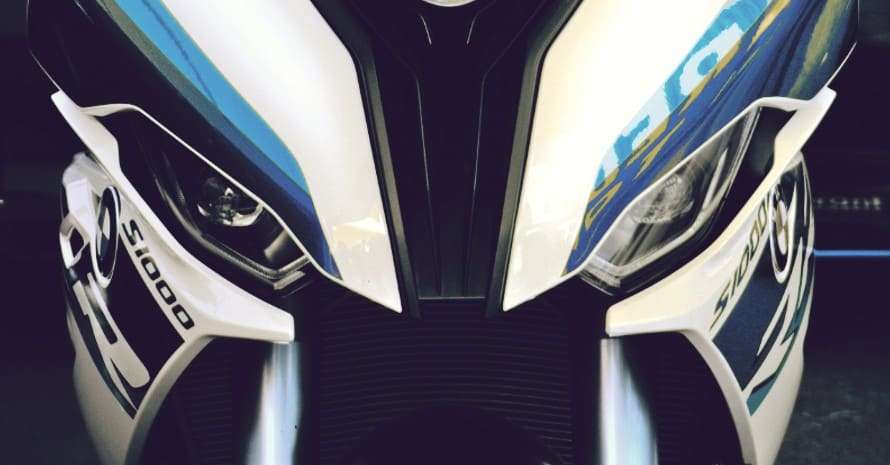Harley-Davidson motorbikes are widely recognized as iconic and have a long-standing history that extends for 120 years. The brand was established in 1903 in Milwaukee, Wisconsin, through the joint efforts of William S. Harley, Arthur Davidson, and several others, combining engineering and fabrication. When the Harley first entered the scene in 1903, its impact was unimaginable, given how it would become such a dominant force in the motorcycle industry. The brand prospered, enduring the test of time, even as other pioneers in the motorcycle industry gradually faded away. This article brings you through the development of Serial Number 1 – the very first real Harley. It was made more than a hundred years after the creation of the first motorcycle of the world – the Daimler Reitwagen manufactured by Gottlieb Daimler and Wilhelm Maybach in 1885, which is widely recognized as the world’s first motorcycle or the ancestor of the motorcycle we know today.
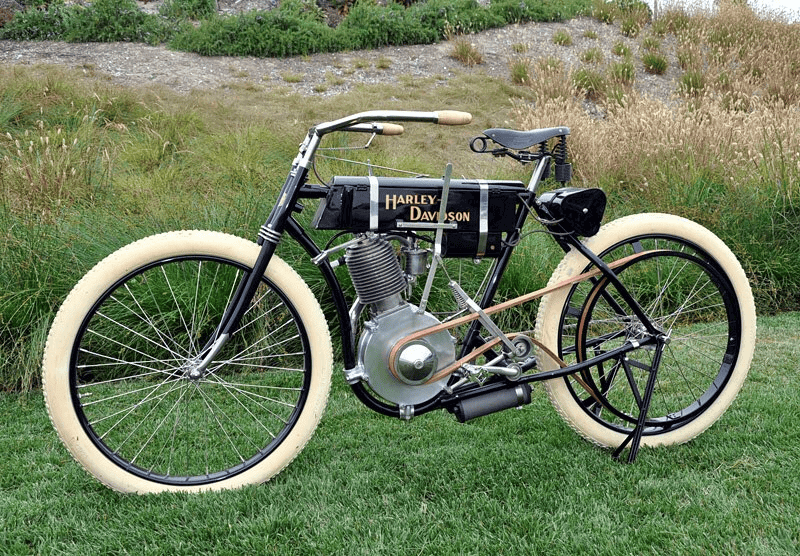
Brief History of the Company
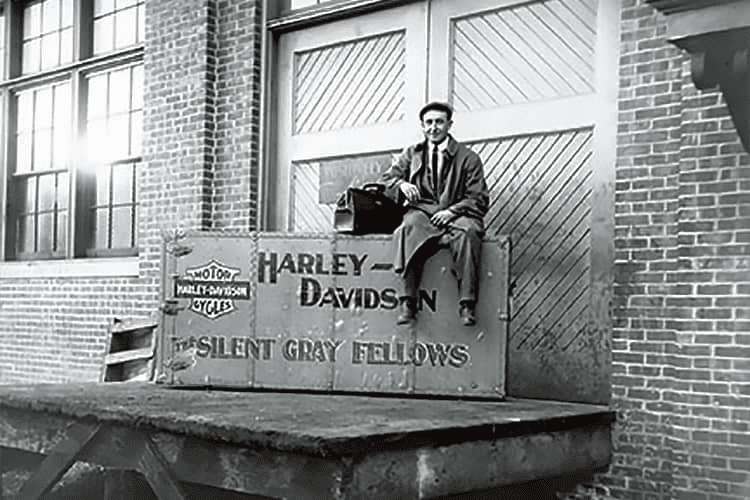
Childhood friends William Harley and Arthur Davidson are the ones to credit for the creation of the brand. Both had an early fascination with bicycles and worked on prototypes for motorcycles in their spare time.
William S. Harley collaborated with Arthur and Walter Davidson to construct a “motor-bicycle” by devising blueprints for a compact engine that could fit onto a conventional bike frame. Over the next two years, they worked on their motor-bicycle using the northside Milwaukee machine shop at the home of their friend Henry Melk. In 1903, they completed the inaugural model. Although the initial trial proved to be relatively fruitful, the motorbike was unable to go up the hills without the rider’s help in pedaling. That is why the first version of HD Motorcycle looked like a bike or was a bicycle.

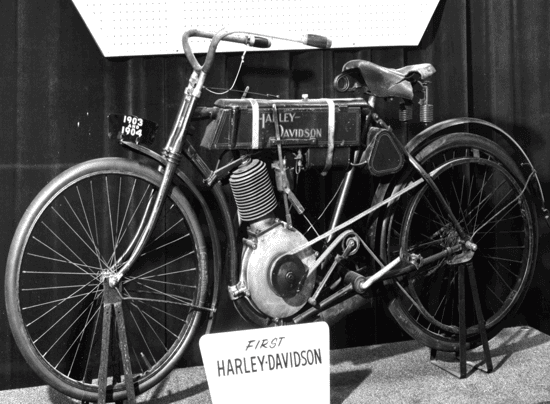
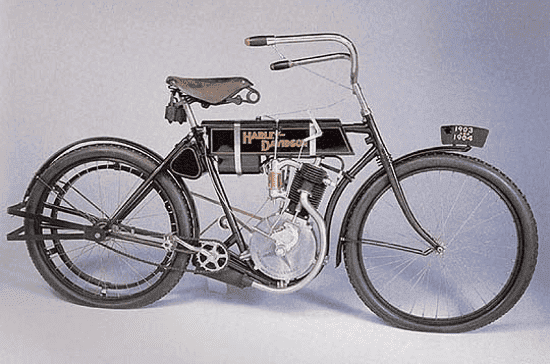
Harley Davidson 1903 Prototype (Model 0)
Despite the initial setback, Harley, Arthur, and Walter were not deterred. Instead, they promptly set to work on a superior model. They designed a larger engine and a loop-frame layout to enhance the bike’s performance. They completed the prototype in 1904 and registered it in a nearby motorcycle race at the State Fair Park, where it secured fourth place.
With a functional prototype in hand, Harley and the Davidson brothers took a significant step forward by having bare Harley-Davidson engines featured in the January 1905 issue of the Automobile and Cycle Trade Journal. Remarkably, a mere four months later, they began manufacturing motorcycles. In their first year, they produced five bikes, of which the first Harley-Davidson dealer, Carl H. Lang of Chicago, sold three.
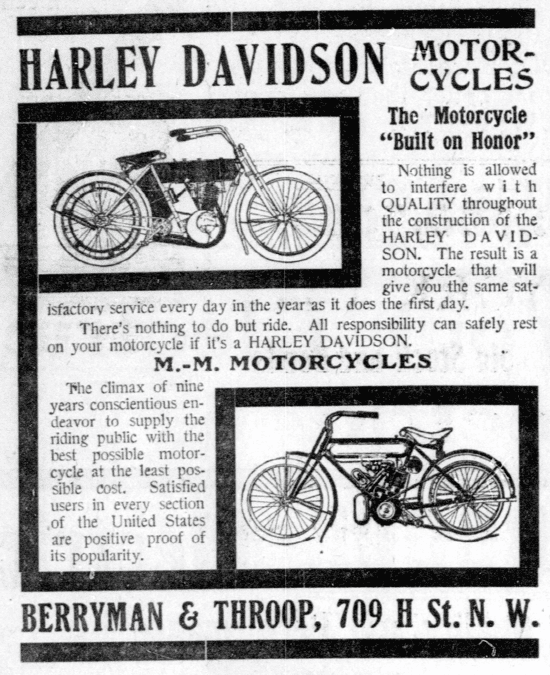
In 1906, Harley, Arthur, and Walter relocated from their workshop to their initial factory, situated at the present-day Harley-Davidson headquarters. In the new facility, they ramped up production, manufacturing 50 motorcycles in the first year alone, which was a ten-fold increase from the previous year. Within one year, they were ready to extend the factory by adding a second floor. In September of that year, they officially established the Harley-Davidson company. The following year, they sold 150 motorcycles, some of which were bought by police departments.
Over the years, Harley-Davidson underwent continued growth and advancement, regularly incorporating new features and designs. The factory was periodically enlarged to keep pace with the ever-increasing demand for their motorcycles.
Harley-Davidson’s contribution to American history is noteworthy. During World War I, the company produced over 20,000 motorcycles for the US military. By 1920, Harley-Davidson had produced 28,189 machines and had dealers in 67 countries. In 1921, Otto Walker set a record on a Harley-Davidson as the first motorcycle to win a race at an average speed of over 100 mph.
Harley-Davidson’s first overhead-valve engine, the Knucklehead, debuted in 1936. The company navigated its way through the Great Depression – one of only two American motorcycle makers to survive (Indian was the other). During the Second World War, Harley-Davidson manufactured more than 90,000 motorcycles for use by the U.S. military and its allies, cementing an enduring relationship between the two entities, visible today in HD’s military benefits program. In recognition of their wartime efforts, Harley-Davidson received two Army-Navy “E” Awards for Excellence in Production.
Model 1 – History and features
In 1903, William S. Harley and Arthur Davidson created the first prototype of a Harley-Davidson motorcycle. The engine was designed based on the De Dion-Bouton system and had a displacement of 10 cubic inches, producing approximately 2 ps (1.5 kW) of power. However, they were not satisfied with the performance, so they increased the engine’s cubic capacity to 24 cubic inches in 1904. This was achieved through a bore of 76 mm and a stroke of 89 mm. Two copies of this pre-production model were made.
The initial version of the loop-frame Harley-Davidson was built in a modest 10 ft x 15 ft (3.0 m x 4.6 m) shed situated in the Davidson family’s backyard. While some of the crucial components were fabricated elsewhere, including likely at the West Milwaukee rail shops where William A. Davidson, the oldest brother, served as toolroom foreman.
In 1905, the initial production run of the Harley-Davidson Model No. 1 commenced in Milwaukee, Wisconsin, USA. This model was quite similar to the bikes created in previous years, as it utilized an inlet-over-exhaust single engine with a 24.74 cubic inch capacity. It was equipped with a single-speed belt drive transmission, and the frame was a tubular loop design weighing 1,851 pounds. With a maximum speed of 40 mph, the Model No. 1 often required additional pedal power when the engine could not generate sufficient power on its own.
The company was producing complete bikes on a limited basis, however. Research by H-D Archives staff and external experts proved that Harley-Davidson Serial Number One was built without fenders and used in competition, probably to illustrate the power and reliability of the motor. After all, as the company name implied, Harley-Davidson Motor Company sold motors as well as motorcycles.
During its initial production, the motorcycle was priced at $200, which was considered quite expensive at the time. Only 38 units of the motorcycle were manufactured, and a replica of the first production bike is presently exhibited in the foyer of the company’s headquarters.
Following the release of the Model No. 1, Harley-Davidson established a solid reputation with their single-cylinder 24 cubic-inch motorcycles and was poised to enter the motorcycle manufacturing industry in earnest. Within a year of producing its first production bike, Harley-Davidson constructed its inaugural factory on Juneau Avenue in 1906.
Harley-Davidson made enhancements to its creation by increasing the engine size to 26.8 cubic inches and introducing a rudimentary spring suspension system at the front end. Additionally, the model offered a color option of Renault Gray with a red pinstripe, which led to the nickname “The Silent Gray Fellow.” This highly unique 1906 Harley was the historical foundation of the company.
At the outset, Harley-Davidson focused on manufacturing single-cylinder motorcycles featuring atmospheric valve control and leather belt drive. This continued until 1909 when the company introduced the H-D V-twin motorcycles.
Harley Davidson Model 1 in Collections and Museums
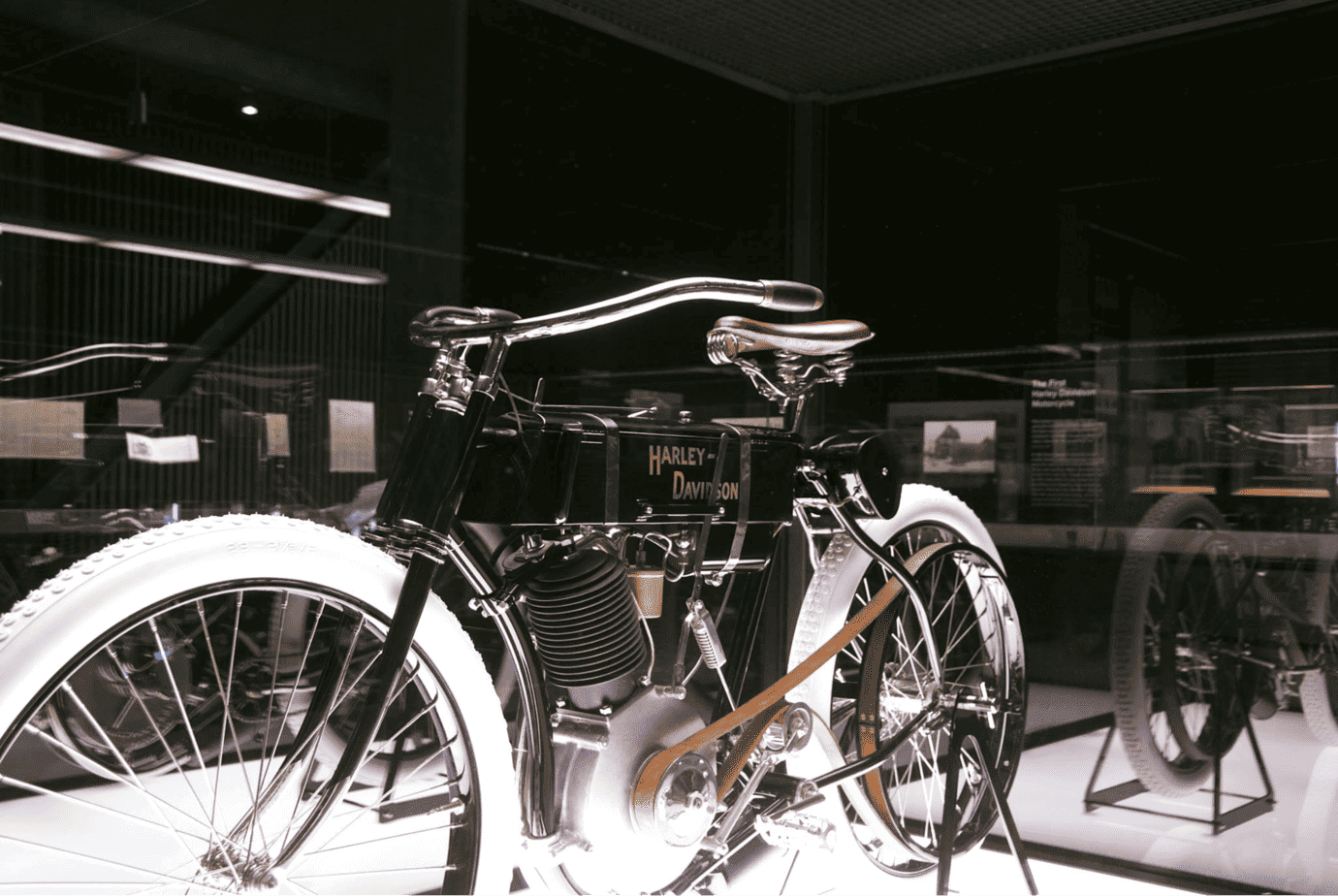
The oldest known Harley Davidson in existence is displayed in a glass case at the Harley Davidson Museum in Milwaukee. In 2016 Bill Rodencal, the Vehicle Collections Specialist at Harley-Davidson Archives has recently given the original motorcycle a makeover using a set of G&J 28×2-1/2 all-white button tread tires. The bike has been expertly restored and preserved as an important part of the museum’s collection. The new tires blend seamlessly with the bike’s vintage aesthetic and accurately represent the style of the early 1900s. Overall, the new tires offer an authentic and historically accurate look to the motorcycle. It can be accessed through the permanent exhibition “The Harley-Davidson Journey” where the story opens with the famous “Serial Number One.” The five-gallery permanent exhibition on the 1st floor tells the story of the people, culture, and history of the company that “created” Harley Davidson Motorcycles.

One of the oldest, totally original, operating Harley Davidson motorcycles is owned by Bob Laidlaw from California, USA
Get your own Harley Davidson Model 1
An extremely rare 1908 Strap Tank Harley-Davidson is now the most expensive motorcycle ever sold at auction after selling for $935,000, after auction fees, last month in Las Vegas.
— USA TODAY (@USATODAY) February 11, 2023
It’s believed to be one of only 12 of the model in the world. https://t.co/gMdwb7YbAj
Classic Harleys are expensive! Almost 120 years later, the Harley-Davidson Model No. 1 is worth $15 million as valued by Hagerty Broker. It is the oldest motorcycle from the company, which is unbelievably still in existence today. However, you can always find a good-quality replica. For me, for example, this one offered by Heroes Motors in Los Angeles is an absolute masterpiece:
You can even find one on ebay
Interesting Facts
- During World War I, approximately half of Harley-Davidson’s sales were to the U.S. military. In response to the demand, the company opened a service school in Milwaukee to train Army mechanics.
- In 1920, Harley-Davidson finished construction of their facility on Juneau Avenue, which stands seven stories tall. The building is still in use today and serves as the company’s corporate office center.
- Between 1941 and 1945, Harley-Davidson communicated to its dealers that they would receive one new motorcycle per model year throughout World War II, as the company had military obligations to fulfill. During this period, an estimated 88,000 motorcycles were manufactured by Harley-Davidson specifically for the military, in addition to a large inventory of replacement parts.
- Harley-Davidson’s V-twin engine had its origin in 1909 when the company mounted its first V-twin engine on a frame. This engine has since been closely associated with Harley-Davidson motorcycles, even though the initial iteration of the V-twin was not a high performer and only remained in production for a single year.
- The first Harley-Davidson carburetor was made from a tomato can (not really) – It is commonly believed that the first Harley-Davidson motorcycle was equipped with a single-cylinder engine, could reach a top speed of 25 mph, and used a tomato can as a makeshift carburetor. However, this claim may be more fiction than fact. While some sources, such as Encyclopedia.com and the book Everything You Need to Know: Harley-Davidson Motorcycles, include this information in their accounts of Harley-Davidson’s history, others are more dubious of its veracity.
- Harleys are called “hogs.” – Harley-Davidson motorcycles are often referred to as “hogs,” but the origin of this nickname is not related to their size or sound. Instead, the term was adopted because a piglet owned by Harley racing team member Ray Weishaar became the team’s mascot. After winning races, the team would take a victory lap with their porcine companion, cementing the association between Harley-Davidson motorcycles and the nickname “hog.”
Lastly, here is a brief list of important dates in the history of Harley Davidson:
- 1903: William S. Harley, 23, and Arthur Davidson, 22, offer the first Harley-Davidson motorcycle. The pair built it in a 10-by-15-foot wooden shed with the words “Harley-Davidson Motor Company” scrawled on the door.
- 1904: The first Harley-Davidson dealer opens in Chicago.
- 1906: The first Harley factory is built in Milwaukee.
- 1907: Harley-Davidson Motor Co. is incorporated.
- 1909: The company introduces its first V-Twin powered motorcycle, built with two cylinders at a 45-degree angle.
- 1913: The company enters motorcycle racing.
- 1915: Harley offers motorcycles with three-speed transmissions.
- 1918: Harley helps out the World War I effort with 20,000 motorcycles. The first American to enter Germany after the Armistice is signed is Cpl. Roy Holtz of Chippewa Falls, Wis., who rides a Harley across the border.
- 1925: The motorcycles now have gas tanks with a distinct teardrop shape. The basic appearance of Harleys will remain virtually the same through the present.
- 1936: Harley introduces the EL, which earns the nickname “Knucklehead” because of the shape of its rocker boxes, which cover the valves that control the fuel and the exhaust.
- 1942-45: Harley makes almost 90,000 motorcycles for the military during World War II.
- 1949: Hydraulic front forks first appear on the new Hydra-Glide models.
- 1952: The K model is introduced, eventually evolving into the Sportster.
- 1957: The Sportster debuts, the first of the “Superbikes.”
- 1962: The company establishes the Tomahawk Division.
- 1964: The three-wheeled Servi car becomes the first Harley-Davidson motorcycle with an electric starter.
Bruce was born in Atlanta. He started riding motorcycles when he was 10 and has been passionate about them since. Bruce says he feels absolute freedom when he’s on two wheels. He prefers riding his bike slowly and smoothly along a country road and hardly ever enjoys wildly speedy rides. With a strong Ducati Multistrada 1200 in the current stable, Bruce enjoys his super powerful, comfortable and easy rides. Ducati Diavel is the beast he’s currently dreaming about…
